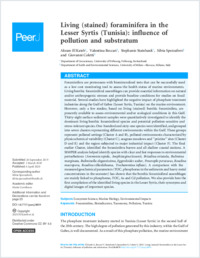Living (stained) foraminifera in the Lesser Syrtis (Tunisia): influence of pollution and substratum
- El Kateb, Akram Department of Geosciences, University of Fribourg, Fribourg, Switzerland
- Beccari, Valentina Department of Geosciences, University of Fribourg, Fribourg, Switzerland
- Stainbank, Stephanie Department of Geosciences, University of Fribourg, Fribourg, Switzerland
- Spezzaferri, Silvia Department of Geosciences, University of Fribourg, Fribourg, Switzerland
- Coletti, Giovanni Department of Earth and Environmental Sciences, University of Milan—Bicocca, Milano, Italy
-
06.04.2020
Published in:
- PeerJ. - 2020, p. e8839
English
Foraminifera are protozoans with biomineralized tests that can be successfully used as a low cost monitoring tool to assess the health status of marine environments. Living benthic foraminiferal assemblages can provide essential information on natural and/or anthropogenic stresses and provide baseline conditions for studies on fossil material. Several studies have highlighted the negative impact of phosphate treatment industries along the Gulf of Gabes (Lesser Syrtis, Tunisia) on the marine environment. However, only a few studies, based on living (stained) benthic foraminifera, are presently available to assess environmental and/or ecological conditions in this Gulf. Thirty-eight surface sediment samples were quantitatively investigated to identify the dominant living benthic foraminiferal species and potential pollution-sensitive and stress-tolerant species. One-hundred and sixty-one species were identified, and grouped into seven clusters representing different environments within the Gulf. These groups represent polluted settings (Cluster A and B), polluted environments characterized by physicochemical variability (Cluster C), seagrass meadows and “pristine” sites (Cluster D and E) and the region subjected to major industrial impact (Cluster F). The final outlier Cluster, identified the foraminifera barren and all shallow coastal stations. A SIMPER analysis helped identify species with clear and fast responses to environmental perturbations (Ammonia tepida, Amphistegina lessonii, Brizalina striatula, Bulimina marginata, Buliminella elegantissima, Eggereloides scaber, Peneroplis perutusus, Rosalina macropora, Rosalina villardeboana, Trochammina inflata). A comparison with the measured geochemical parameters (TOC, phosphorus in the sediments and heavy metal concentrations in the seawater) has shown that the benthic foraminiferal assemblages are mainly linked to phosphorus, TOC, As and Cd pollution. We also provide here the first compilation of the identified living species in the Lesser Syrtis, their synonyms and digital images of important species.
- Faculty
- Faculté des sciences et de médecine
- Department
- Département de Géosciences
- Language
-
- English
- Classification
- Biological sciences
- License
- License undefined
- Identifiers
-
- RERO DOC 328477
- DOI 10.7717/peerj.8839
- Persistent URL
- https://folia.unifr.ch/unifr/documents/308675
Statistics
Document views: 73
File downloads:
- spe_lfl.pdf: 106
